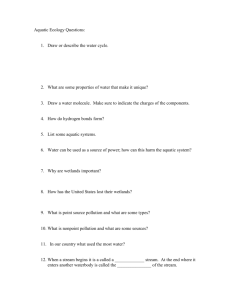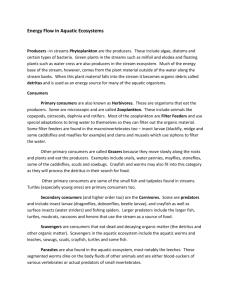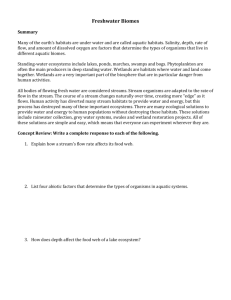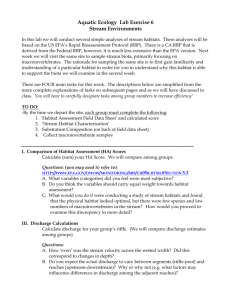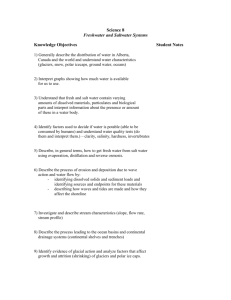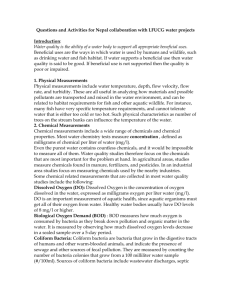SECTION .0500 - MINIMUM STREAM FLOWS TO MAINTAIN
advertisement
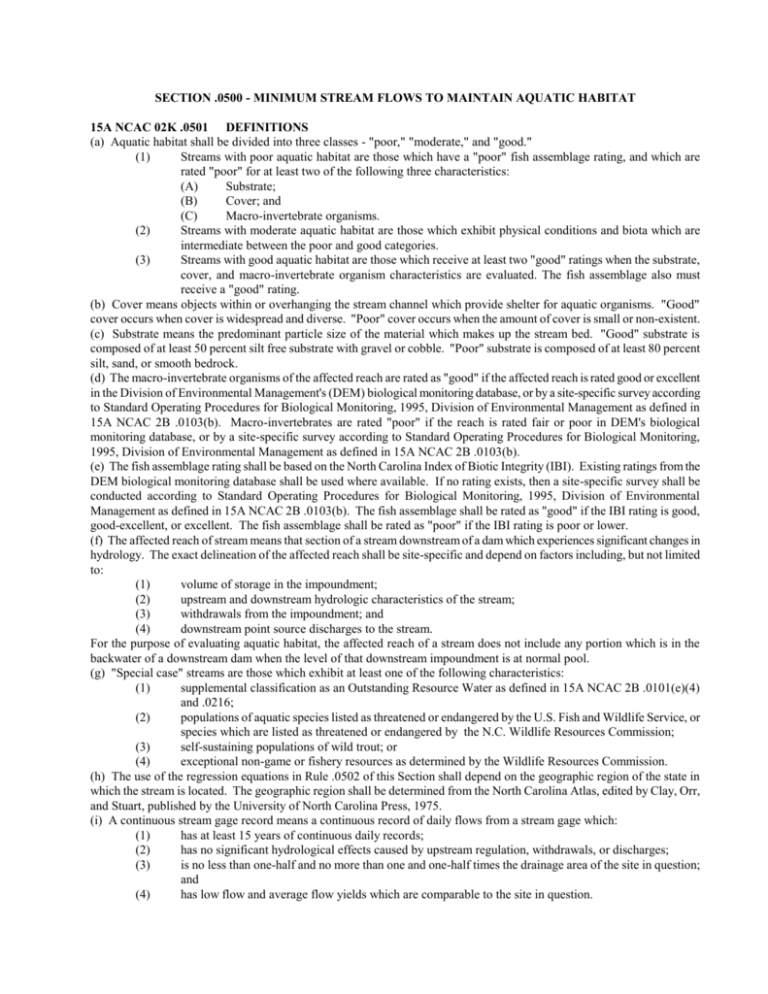
SECTION .0500 - MINIMUM STREAM FLOWS TO MAINTAIN AQUATIC HABITAT 15A NCAC 02K .0501 DEFINITIONS (a) Aquatic habitat shall be divided into three classes - "poor," "moderate," and "good." (1) Streams with poor aquatic habitat are those which have a "poor" fish assemblage rating, and which are rated "poor" for at least two of the following three characteristics: (A) Substrate; (B) Cover; and (C) Macro-invertebrate organisms. (2) Streams with moderate aquatic habitat are those which exhibit physical conditions and biota which are intermediate between the poor and good categories. (3) Streams with good aquatic habitat are those which receive at least two "good" ratings when the substrate, cover, and macro-invertebrate organism characteristics are evaluated. The fish assemblage also must receive a "good" rating. (b) Cover means objects within or overhanging the stream channel which provide shelter for aquatic organisms. "Good" cover occurs when cover is widespread and diverse. "Poor" cover occurs when the amount of cover is small or non-existent. (c) Substrate means the predominant particle size of the material which makes up the stream bed. "Good" substrate is composed of at least 50 percent silt free substrate with gravel or cobble. "Poor" substrate is composed of at least 80 percent silt, sand, or smooth bedrock. (d) The macro-invertebrate organisms of the affected reach are rated as "good" if the affected reach is rated good or excellent in the Division of Environmental Management's (DEM) biological monitoring database, or by a site-specific survey according to Standard Operating Procedures for Biological Monitoring, 1995, Division of Environmental Management as defined in 15A NCAC 2B .0103(b). Macro-invertebrates are rated "poor" if the reach is rated fair or poor in DEM's biological monitoring database, or by a site-specific survey according to Standard Operating Procedures for Biological Monitoring, 1995, Division of Environmental Management as defined in 15A NCAC 2B .0103(b). (e) The fish assemblage rating shall be based on the North Carolina Index of Biotic Integrity (IBI). Existing ratings from the DEM biological monitoring database shall be used where available. If no rating exists, then a site-specific survey shall be conducted according to Standard Operating Procedures for Biological Monitoring, 1995, Division of Environmental Management as defined in 15A NCAC 2B .0103(b). The fish assemblage shall be rated as "good" if the IBI rating is good, good-excellent, or excellent. The fish assemblage shall be rated as "poor" if the IBI rating is poor or lower. (f) The affected reach of stream means that section of a stream downstream of a dam which experiences significant changes in hydrology. The exact delineation of the affected reach shall be site-specific and depend on factors including, but not limited to: (1) volume of storage in the impoundment; (2) upstream and downstream hydrologic characteristics of the stream; (3) withdrawals from the impoundment; and (4) downstream point source discharges to the stream. For the purpose of evaluating aquatic habitat, the affected reach of a stream does not include any portion which is in the backwater of a downstream dam when the level of that downstream impoundment is at normal pool. (g) "Special case" streams are those which exhibit at least one of the following characteristics: (1) supplemental classification as an Outstanding Resource Water as defined in 15A NCAC 2B .0101(e)(4) and .0216; (2) populations of aquatic species listed as threatened or endangered by the U.S. Fish and Wildlife Service, or species which are listed as threatened or endangered by the N.C. Wildlife Resources Commission; (3) self-sustaining populations of wild trout; or (4) exceptional non-game or fishery resources as determined by the Wildlife Resources Commission. (h) The use of the regression equations in Rule .0502 of this Section shall depend on the geographic region of the state in which the stream is located. The geographic region shall be determined from the North Carolina Atlas, edited by Clay, Orr, and Stuart, published by the University of North Carolina Press, 1975. (i) A continuous stream gage record means a continuous record of daily flows from a stream gage which: (1) has at least 15 years of continuous daily records; (2) has no significant hydrological effects caused by upstream regulation, withdrawals, or discharges; (3) is no less than one-half and no more than one and one-half times the drainage area of the site in question; and (4) has low flow and average flow yields which are comparable to the site in question. (j) A site-specific instream flow study conducted by the applicant or his consultants, which is subject to approval by the Department, means a study performed according to the following conditions: (1) A plan of study shall be developed in consultation with the Department and submitted to the Department for review and approval prior to commencement of the study. (2) The plan of study shall identify the aquatic habitat parameters to be evaluated by the study. The selection of these parameters shall depend on factors including, but not limited to: (A) the aquatic species being evaluated; (B) the habitat quality of the affected reach; and (C) existing or potential water shortages or water use conflicts. (3) The Department shall have the option of participating in the collection of all field data, and shall be notified prior to collection of any set of data. (4) The results of the study shall accurately determine the parameters identified during study design. (5) The Department may review the field data and results of these studies to determine the stream flow needed to maintain aquatic habitat. History Note: Authority G.S. 143-215.24; 143-215.25; 143-215.31; 143-215.32; 143-215.33; 143-215.36; Eff. December 1, 1994; Amended Eff. April 1, 1995.
